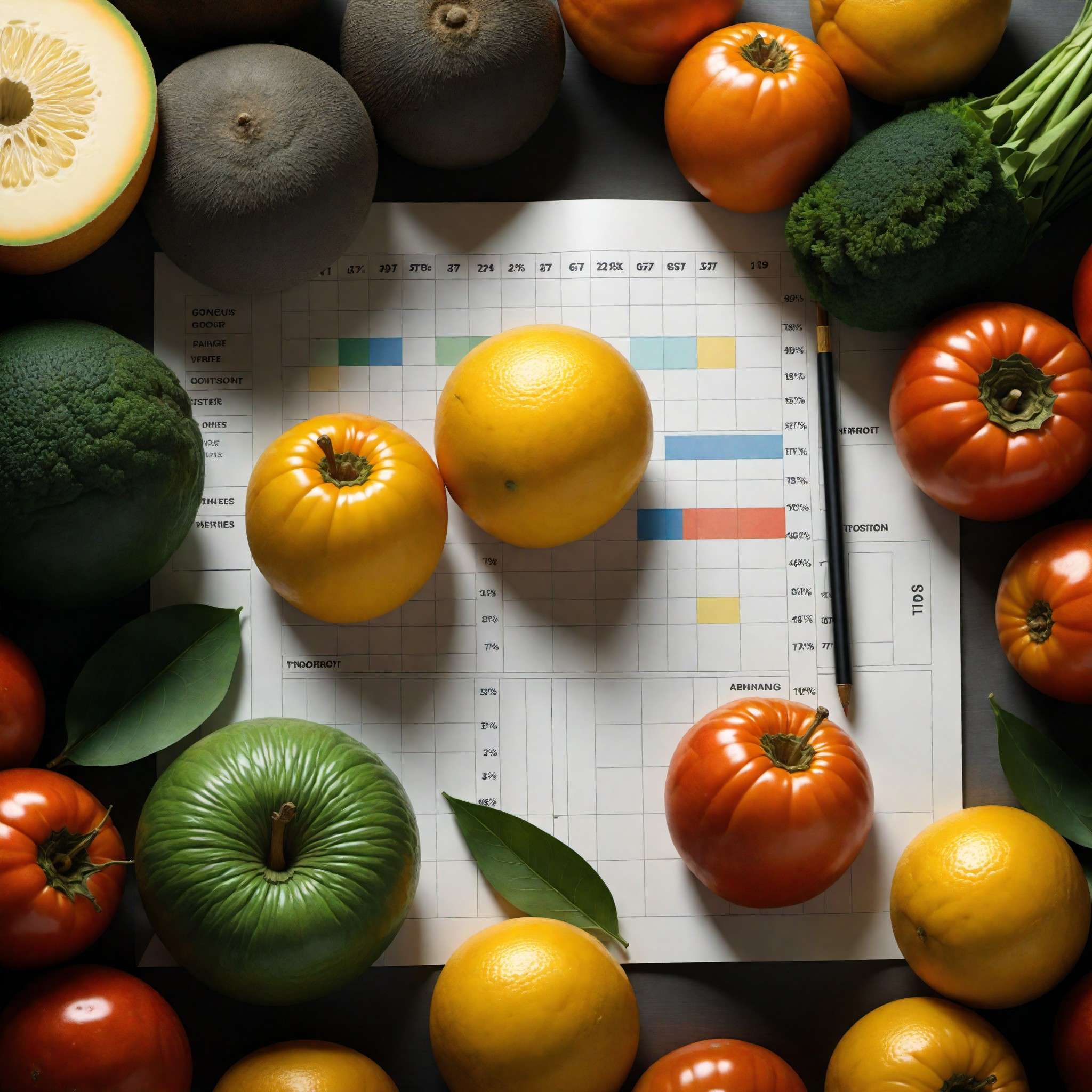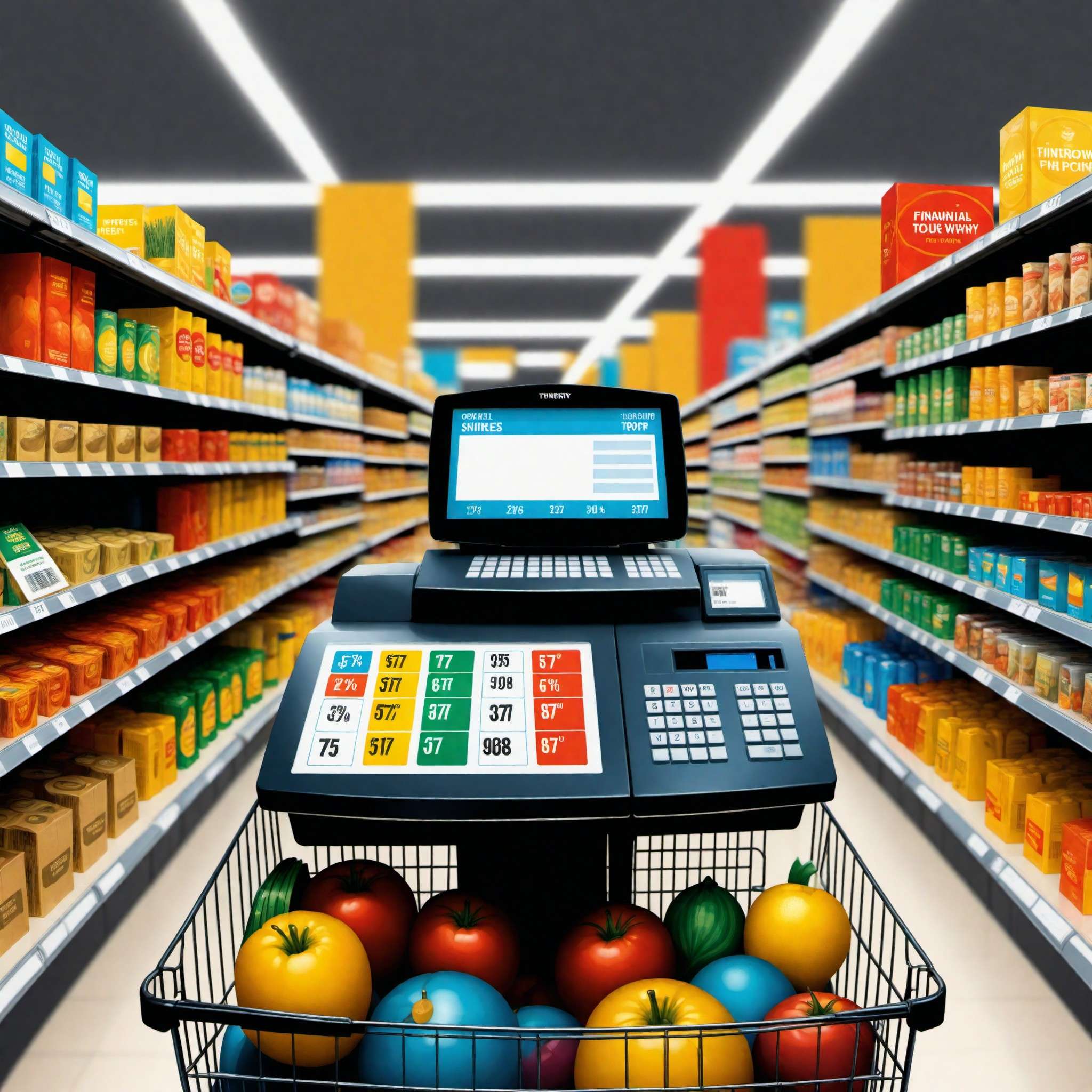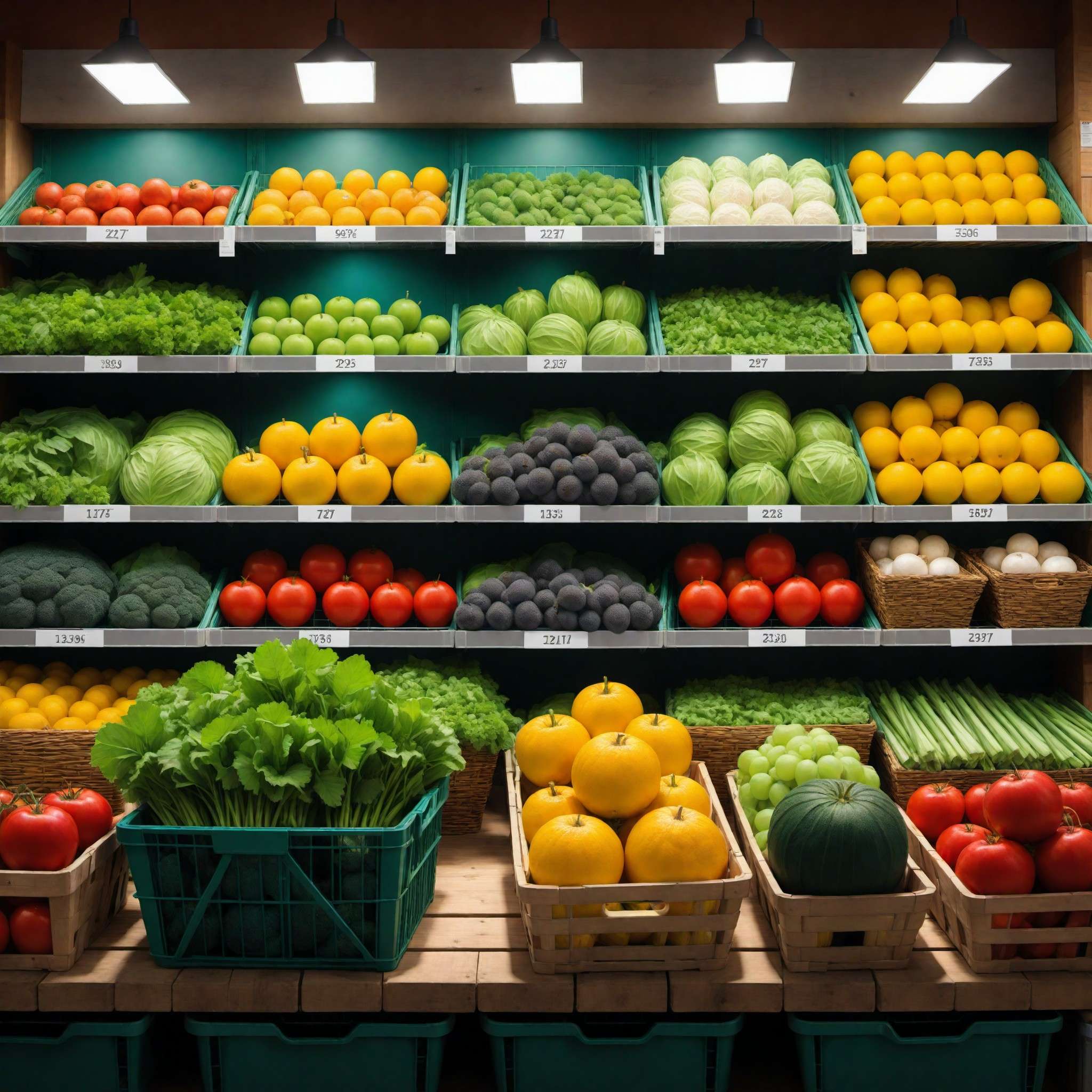Zombie Bunny is Reader-supported and may earn an affiliate commission through links on our site.

Slash Your Grocery Bill in Half: Money-Saving Tips for the Supermarket
Master the art of saving on groceries without compromising meal quality! Learn practical tips to cut your grocery bill and promote smarter spending habits.
Discover how to save money without sacrificing the quality of your meals! This comprehensive blog post provides practical, easy-to-implement tips to significantly cut your grocery bill in half. Learn how strategic planning, smart shopping, and understanding the value of discounts can free up funds for other priorities. Plus, get insights into how reducing waste, buying in-season produce, and online grocery shopping can lead to substantial savings. Start your journey towards healthier, more varied meals and sustainable savings today. Don’t just spend less, spend wisely.
Introduction: The Art of Saving on Groceries

© Copyright , ZombieBunny.Org
The importance of saving on groceries
In today’s economy, every dollar counts, and the grocery bill is one area where you can make significant savings. Have you ever thought about how much of your income is spent on groceries? For many households, the amount is substantial, making it a prime target for cost-cutting measures.
The importance of saving on groceries cannot be overstated. Not only does it free up funds for other necessities or priorities, but it can also reduce financial stress. The beauty of it is that slashing your grocery bill doesn’t mean compromising on the quality or quantity of your food. On the contrary, smart shopping can often lead to healthier and more varied meals.
Consider the potential impact of reducing your grocery bill by just 10, 20, or even 50 percent. That’s money that could go toward paying down debt, boosting your savings account, or funding a much-needed family vacation. Plus, the skills you use to save on groceries – planning, budgeting, and bargain hunting – are applicable to many other areas of life.
So, how do you go about cutting your grocery bill in half? This blog post will provide you with a plethora of practical, easy-to-implement tips to help you save big on your supermarket shopping. Let’s start this journey towards sustainable savings together.
How much an average family spends on groceries
Understanding the financial implications of grocery shopping begins with recognizing how much an average family spends on groceries. According to the U.S. Bureau of Labor Statistics, the average American family spent approximately $4,643 on groceries in 2019. This amount makes up a significant portion of the average household’s annual income.
Location, family size, dietary needs, and lifestyle choices can all impact this spending. A family in New York City may spend more than a family in rural Kansas due to cost of living differences. Similarly, a family of six is likely to have a larger grocery bill than a single individual or couple.
It’s also worth considering the types of products purchased. A household that focuses on organic, gluten-free, or specialty diet foods may have a higher grocery bill due to the premium prices of these items. On the other hand, households that buy in bulk, opt for generic brands, or take advantage of sales and discounts can lower their grocery expenses.
By understanding the average grocery expenditure, you can gauge your own spending and identify if there’s room for improvement. Are you spending significantly more than the average? If so, it may be time to reevaluate your shopping habits and look for ways to save. This blog will guide you through proven strategies to help reduce your grocery bill without sacrificing the quality or enjoyment of your meals.
Potential savings from efficient grocery shopping
So, what are the potential savings from efficient grocery shopping? The answer might surprise you. With the right strategies, you could save thousands of dollars a year. Imagine cutting your grocery bill in half. For the average American family spending $4,643 per year, this would mean a savings of over $2,300!
Efficient grocery shopping is about more than just hunting for discounts. It’s a comprehensive approach that involves meal planning, savvy use of coupons, buying in bulk, and making smart choices about what to buy and when. For instance, opting for seasonal fruits and vegetables can significantly reduce your produce bill. Similarly, choosing store-brand products over name brands often results in substantial savings without compromising on quality.
And let’s not forget about waste reduction. By planning meals and shopping with a purpose, you can avoid buying excess food that ends up in the trash. This is not only good for your wallet, but also for the environment.
In addition to these financial benefits, efficient grocery shopping can also save you time. By planning your shopping trips and knowing exactly what you need, you can cut down on the hours spent wandering supermarket aisles.
In the coming sections of this blog post, we will delve deeper into these strategies, providing practical tips and guidance on how to maximize your grocery savings. So, stay tuned and get ready to slash your grocery bill in half!
Planning Ahead: The Key to Savings

© Copyright , ZombieBunny.Org
The link between planning and saving
The connection between planning and saving is profound, especially when it comes to grocery shopping. Have you ever found yourself wandering aimlessly in supermarket aisles, filling your cart with items that weren’t on your list, only to realize later that you’ve overspent? That’s where planning comes into play.
Taking the time to plan your meals for the week, make a detailed shopping list, and stick to it can significantly reduce your grocery bill. When you know exactly what you need, you’re less likely to be swayed by impulse purchases or buy more than necessary. Plus, planning helps ensure that you have all the ingredients you need for your meals, reducing the need for costly last-minute trips to the store.
Meal planning can also help you take advantage of sales and discounts. For instance, if chicken is on sale, you can plan several meals around it, maximizing your savings. Similarly, you can plan to use ingredients across multiple meals, minimizing waste and getting the most bang for your buck.
But planning doesn’t stop at meal planning and making a shopping list. It also involves budgeting – setting a limit on how much you’ll spend on groceries and sticking to it. By knowing your budget, you can make smarter choices, prioritize your purchases, and avoid overspending.
In essence, planning is a powerful tool for saving money on groceries. It requires a bit of time and effort, but the potential savings make it well worth it.
How to make a meal plan
Creating a meal plan is a strategic approach to grocery shopping that can lead to significant savings. Here’s how you can make a meal plan to boost your savings while ensuring delicious and nutritious meals for your family.
Start by considering your family’s dietary preferences, health goals, and schedule for the week. This will guide your meal choices and ensure that everyone’s needs are catered for. Involve everyone in the meal planning process. This can be a great way to teach kids about nutrition and budgeting, and it ensures everyone looks forward to meal times.
Next, take inventory of what you already have in your pantry, refrigerator, and freezer. Utilizing these items first can cut down on your grocery bill and help prevent food waste.
Now, time to plan your meals. Ideally, plan for all meals – breakfast, lunch, dinner and snacks. Look for recipes that use similar ingredients to maximize your grocery purchases and reduce waste. Don’t forget to plan for leftovers, which can be used for lunches or transformed into another meal.
Once you have your meals planned, create a shopping list of the ingredients you need. Stick to this list when you shop to avoid impulse purchases and ensure you have everything you need.
Meal planning might seem like a daunting task at first, but it quickly becomes second nature. Plus, the benefits – less stress, healthier meals, and significant savings – make it a habit worth cultivating.
The significance of a shopping list
A shopping list is a simple yet powerful tool in your quest to slash your grocery bill. Not only does it ensure that you remember to buy all the ingredients you need for your meals, but it also helps prevent impulse purchases that can quickly inflate your grocery bill.
A shopping list based on a well-thought-out meal plan ensures that every item you purchase has a purpose. You’re not buying items on the off chance you might use them, but because you know exactly when and how they’ll be used. This significantly reduces food waste and ensures your grocery spending is efficient.
Keeping to your shopping list also helps to resist the temptation of sales and discounts that aren’t truly saving you money. Just because an item is on sale doesn’t mean it’s a good deal if it’s not on your list or part of your meal plan.
Moreover, a shopping list can help you streamline your shopping trip, saving you time. Knowing exactly what you need allows you to navigate the supermarket aisles more efficiently and avoid unnecessary browsing.
To make your shopping list even more effective, consider categorizing items by supermarket section (produce, dairy, meats, etc.). This can make your shopping trip more efficient and further reduce the temptation to make impulse buys.
In conclusion, a shopping list is more than just a memory aid – it’s a strategic tool that can lead to significant savings on your grocery bill.
Understanding Sales & Discounts: Shop Smart Not Hard

© Copyright , ZombieBunny.Org
The dynamics of supermarket discounts
Understanding the dynamics of supermarket discounts is crucial to maximizing your grocery savings. Sales and discounts can significantly reduce the cost of your grocery bill, but only if used wisely. It’s important to know that not all discounts are created equal and learning how to discern a true bargain from a marketing ploy is key.
Supermarkets often use discounts to move products that are nearing their sell-by date, to clear out seasonal items, or to promote a new product. While these can provide great savings, it’s important to consider whether you actually need the discounted item and whether you will use it before it expires.
Additionally, supermarkets often place discounted items in prominent positions to attract customers. However, these may not always be the best deals. Often, less expensive alternatives can be found on the higher or lower shelves.
Another common supermarket strategy is the ‘buy more, save more’ offer. While these can provide value, they can also lead to overbuying and food waste. Always consider whether you can realistically consume the items before their expiry date.
Lastly, remember that just because an item is discounted doesn’t mean it’s the cheapest option. Sometimes, store brands or other alternatives may still be cheaper than the discounted name brand.
By understanding the dynamics of supermarket discounts, you can make informed decisions and ensure that you’re truly getting the best deal. Remember, the goal is not just to spend less, but to spend wisely.
How to maximize savings from sales
Maximizing savings from sales requires strategy and discipline. Here are some tips to help you get the most out of supermarket discounts.
Firstly, plan your shopping around sales when possible. Most supermarkets have weekly sales, and these can be a great opportunity to stock up on staples or try out new products. However, be sure to compare prices. Sometimes, even the sale price of a name-brand product can be higher than the regular price of the store brand equivalent.
Secondly, consider buying in bulk during sales, but only for items that you use frequently and that won’t spoil. Items like canned goods, pasta, and rice are good candidates for bulk buying during sales.
Thirdly, use coupons in conjunction with sales for even greater savings. This strategy, known as stacking, can lead to some impressive discounts. Just be sure to read the fine print on both the sale and the coupon to make sure it’s allowed.
Lastly, don’t be swayed by sales to buy items that you don’t need or won’t use. A discount doesn’t save you money if it leads to overbuying or wasting food.
Remember, the key to maximizing savings from sales is to stay focused on your needs and your budget. Don’t let flashy sale signs distract you from your goal of efficient and cost-effective grocery shopping.
Avoiding the discount trap
While sales and discounts can provide excellent opportunities to save, they can also be a pitfall for the unwary shopper. This is often referred to as the discount trap. Falling into this trap can lead to overspending, overbuying, and ultimately wasting food and money.
The allure of a good deal can sometimes cloud our judgement, causing us to purchase items that we don’t really need or won’t use. It’s important to remember that a deal is only a deal if it’s on something you were going to buy anyway. If a sale item isn’t on your shopping list or doesn’t fit into your meal plan, it’s best to pass it by.
Another common discount trap is the ‘buy more, save more’ offers. While these can provide value, they can also lead to buying more than you can realistically use before it spoils. Be particularly wary of these types of deals on perishable items like fresh produce, dairy, and meat.
Lastly, don’t be fooled by the illusion of scarcity that sales can create. Just because an item is on sale now doesn’t mean it won’t be on sale again in the future. Stick to your shopping list and your budget, and remember that there will always be more sales.
By being mindful of these potential pitfalls, you can avoid the discount trap and ensure that sales and discounts are truly saving you money.
Bulk Buying: More for Less

© Copyright , ZombieBunny.Org
The pros and cons of bulk buying
Bulk buying can be a great strategy for slashing your grocery bill, but like any strategy, it has its pros and cons. Understanding these can help you make informed decisions about when and what to buy in bulk.
On the pro side, bulk buying often leads to lower prices per unit, resulting in significant savings over time. This is particularly true for non-perishable items like canned goods, rice, pasta, and toilet paper. Buying in bulk also means fewer shopping trips, saving you time and potentially reducing your carbon footprint.
However, bulk buying has its cons as well. The most obvious one is storage. You need to have sufficient space to store your bulk purchases, and this can be a challenge in smaller homes or apartments. Additionally, the initial cost is higher, even if it’s cheaper in the long run. This means you need to be able to afford the upfront cost.
Another potential downside is waste. If you buy perishable items in bulk and don’t use them before they spoil, you’re not saving money – you’re wasting it. You also run the risk of overconsumption. When you have a lot of something, you might use more of it than you would if you had less.
In conclusion, bulk buying can be a great tool for saving money, but it’s not always the best approach. Consider your storage space, your budget, and your consumption habits before deciding to buy in bulk.
When it’s beneficial to buy in bulk
So when is it beneficial to buy in bulk? While the answer to this question can depend on individual circumstances, there are some general guidelines that can help you make the right decision.
One of the best times to buy in bulk is when non-perishable items you frequently use are on sale. This could include items like canned goods, pasta, rice, or household items like toilet paper and cleaning supplies. Buying these items in bulk when they’re on sale can lead to substantial savings.
Bulk buying can also be beneficial for items that have a long shelf life, even if they’re not non-perishable. This includes frozen foods, which can be stored for months without spoiling, and certain fresh foods like apples or potatoes that can last for several weeks if stored properly.
Another good time to buy in bulk is when you’re preparing for a large event, like a family gathering or a party. In these cases, you know you’ll be using a lot of certain items, making bulk buying a cost-effective option.
However, it’s crucial to remember that bulk buying is only beneficial if you’re able to use the items before they spoil. Always consider your consumption habits and storage capabilities before deciding to buy in bulk. Even if an item is a great deal, it’s not a savings if it ends up in the trash.
Managing storage for bulk items
One of the challenges of bulk buying is managing storage. Buying in large quantities can save you money, but only if you have the space to store your purchases. Here are some tips to help you manage storage for bulk items.
Firstly, organize your storage space. Whether it’s your pantry, your fridge, or your garage, keeping your space organized will make it easier to store and access your bulk purchases. Consider investing in shelving units, storage bins, or can organizers to maximize your space.
Secondly, consider the shelf life of the items you’re buying. Non-perishable items can be stored for a long time, but perishable items need to be used before they spoil. For these items, make sure you have space in your fridge or freezer.
Thirdly, remember to rotate your stock. When you add new items to your storage, move the older items to the front so they get used first. This is particularly important for perishable items to prevent them from spoiling.
Lastly, consider splitting bulk purchases with family or friends. This allows you to benefit from the cost savings of bulk buying without the storage headaches.
In conclusion, managing storage for bulk items requires some planning and organization. But with the right strategies, you can make bulk buying work for you and reap the cost savings.
Generic vs. Brand Name: The Price-Quality Balancing Act

© Copyright , ZombieBunny.Org
Comparing brand name vs. generic products
When it comes to saving money on groceries, one of the key decisions you’ll make is choosing between brand name and generic products. Understanding the differences and similarities between these can help you make informed decisions that balance price and quality.
Brand name products often come with a higher price tag due to factors like marketing costs, packaging, and the perceived value associated with the brand. However, a higher price doesn’t necessarily equate to higher quality. In fact, many generic products are manufactured in the same facilities as their brand name counterparts, using the same ingredients and quality control measures.
On the other hand, generic products, often referred to as store brands, are usually cheaper than brand name products. This is because they spend less on advertising and packaging, and these savings are passed on to the consumer.
However, not all generic products are created equal. Some may match the quality of their brand name equivalents, while others may fall short. It’s worth trying different generic products to see which ones meet your quality expectations.
In some cases, the choice between brand name and generic could come down to personal preference. Maybe you prefer the taste of a certain brand name product, or maybe a generic product works just as well for you.
Ultimately, the decision should be based on a balance of price and quality that aligns with your budget and your needs. By making informed choices, you can enjoy significant savings on your grocery bill.
When it’s worth to buy brand name
Although generic products can offer substantial savings, there are times when it might be worth paying a bit more for a brand name product. The key is to know when to make that choice.
One instance where it may be worth buying brand name is when the quality or performance of a product is crucial. For example, certain cooking ingredients like olive oil, spices, or chocolate can greatly affect the outcome of a recipe. If you’ve found a brand that delivers the quality you need, it may be worth sticking with it.
Another situation is when it comes to products with health implications. If you or a family member has allergies or dietary restrictions, you might feel more comfortable sticking with a brand name product that you trust.
Personal preference can also play a role. Maybe you’ve tried the generic version of a product and didn’t like it as much, or perhaps a certain brand holds sentimental value or aligns with your values in some way.
However, it’s important to remember that brand name doesn’t always mean better quality. Often, you’re paying for marketing, packaging, and the brand name itself. Therefore, it’s worth giving generic products a try – you might find that they meet or even exceed your expectations.
In the end, deciding when to buy brand name comes down to assessing the value that the product offers you – not just in terms of cost, but also in terms of quality, health, and personal satisfaction.
Maximizing savings with generic products
Generic products, also known as store brands, can be a goldmine of savings for the savvy shopper. They typically cost less than name brands due to lower marketing and packaging costs, and the quality is often comparable.
To maximize your savings with generic products, start by identifying the staples in your shopping list. Items like rice, pasta, canned goods, and household supplies are often indistinguishable in quality between name brand and generic. Experiment with different generic products to see which ones meet your quality standards.
Another strategy is to watch for sales on generic products. While they’re usually cheaper to begin with, getting them on sale can lead to even more savings.
Don’t be afraid to compare labels. Often, you’ll find that the ingredients and nutritional information of the generic product are nearly identical to the brand name.
Also, remember that generic doesn’t mean lower quality. Many store brands are made by the same manufacturers that produce the name brand equivalents. In fact, some generic products may even come from the same production line as their name brand counterparts.
Finally, keep an open mind. While there may be some brand name products that you’re loyal to, being willing to try generic versions can lead to significant savings. By incorporating more generic products into your shopping routine, you can slash your grocery bill without sacrificing quality or enjoyment of your meals.
Implementing Coupons: The Art of the Deal

© Copyright , ZombieBunny.Org
How to effectively use coupons
Coupons can be an excellent tool for reducing your grocery bill, but to make the most of them, you need to use them effectively. Here are some strategies to help you become a couponing pro.
The first step is to find coupons for products you actually use. Collecting coupons for items you don’t need or won’t use won’t save you money. You can find coupons in newspapers, online, or through apps.
Once you have your coupons, organize them in a way that makes sense to you. Some people like to organize their coupons by product category, while others prefer to organize them by expiration date. Find a system that works for you and stick with it.
Try to combine coupons with sales for maximum savings. This strategy, known as stacking, can lead to some impressive discounts. It requires a bit of planning and organization, but the savings can be well worth it.
Always read the fine print on your coupons. Be aware of any restrictions or requirements and make sure to use your coupons before they expire.
Finally, don’t let coupons dictate your shopping. Just because you have a coupon for a product doesn’t mean you should buy it. Use coupons as a tool to reduce the cost of items you were planning to buy anyway.
By using coupons effectively, you can significantly reduce your grocery bill and enjoy the satisfaction of scoring a great deal.
Where to find the best coupon deals
Finding the best coupon deals can feel like a treasure hunt, but knowing where to look can make it much easier. Here are some sources to help you find the best coupon deals for your grocery shopping.
Firstly, don’t overlook the traditional sources like newspapers and direct mail. These often contain coupon inserts from various brands and can be a great source of savings.
Another place to look is online. Many brands offer printable coupons on their websites. Similarly, there are numerous websites and apps dedicated to collecting and sharing coupons. Some of the most popular ones include Coupons.com, RetailMeNot, and SmartSource.
Additionally, don’t forget about the supermarket itself. Many supermarkets offer digital coupons on their websites or through their mobile apps. They may also have coupon dispensers in their aisles or offer coupons at the checkout.
Social media can be another source of coupons. Many brands share special deals and coupons on their social media pages, so it’s worth following your favorite brands on platforms like Facebook, Twitter, or Instagram.
Finally, consider signing up for newsletters from your favorite brands or supermarkets. These often include coupons or information about upcoming sales.
Remember, the key to maximizing your coupon savings is to use them strategically. Focus on finding and using coupons for products that you use regularly and that fit into your meal plan and budget. With a bit of planning and organization, couponing can become a rewarding way to slash your grocery bill.
The realities of extreme couponing
Extreme couponing — the practice of collecting and using a large number of coupons to get items for free or nearly free — has been popularized by reality TV shows. But what does it really entail, and is it a feasible strategy for the average shopper?
Extreme couponing requires a significant investment of time and effort. It involves collecting coupons from multiple sources, organizing them, keeping track of various sales, and often making multiple shopping trips to different stores. It’s not uncommon for extreme couponers to spend several hours a week on their couponing activities.
Moreover, extreme couponing can lead to buying items simply because they’re free or nearly free, not because they’re needed. This can result in overbuying and potentially wasting food and other products.
Extreme couponing can also lead to a large stockpile of items. While having a stockpile can be beneficial in certain situations, it requires ample storage space. Plus, you need to be mindful of the expiration dates to prevent items from going to waste.
In conclusion, while extreme couponing can lead to impressive savings, it’s not a strategy that suits everyone. It requires a significant commitment and can lead to overconsumption and waste. For most people, a more moderate approach to couponing — focusing on coupons for items they regularly use and can store — is likely to be a more feasible and effective strategy for saving money on groceries.
Seasonal Shopping: Fresh and Affordable

© Copyright , ZombieBunny.Org
Benefits of buying in-season produce
Buying in-season produce is a smart strategy for both your wallet and your taste buds. Here’s why.
Firstly, in-season produce is often cheaper. When fruits and vegetables are in season, they’re abundant and cheaper to harvest and distribute. This means lower prices for you at the supermarket.
Secondly, in-season produce typically tastes better. Fruits and vegetables are at their peak of flavor when they’re in season. Plus, because they’re harvested at the right time, they’re also likely to be more nutritious.
Buying in-season also supports local farmers and the local economy. When you buy in-season produce, you’re more likely to be buying items that were grown locally rather than shipped from another part of the world. This not only supports local farmers, but also reduces the carbon footprint associated with your food.
Lastly, buying in-season can add variety to your diet. The changing seasons bring different fruits and vegetables into season, providing an opportunity to try new foods and recipes.
To take advantage of the benefits of buying in-season produce, get familiar with the growing seasons in your area. Many resources are available online or through local agriculture extension offices.
In conclusion, buying in-season produce is a win-win. It’s a simple, effective way to save money while enjoying fresh, delicious, and nutritious food.
Understanding the produce seasonal calendar
Understanding the produce seasonal calendar can be a powerful tool in your money-saving arsenal. But what does this mean, and how can you utilize it?
The produce seasonal calendar simply refers to the times of the year when different fruits and vegetables are in their growing season. During these periods, these items are typically more abundant, fresher, and less expensive.
For example, strawberries and asparagus hit their peak in spring, while sweet corn and tomatoes are summer staples. Apples and pumpkins come into season in the fall, and winter is the time for citrus fruits and root vegetables.
By familiarizing yourself with the produce seasonal calendar in your area, you can plan your meals and shopping lists around what’s in season. This not only allows you to enjoy fresh, flavorful produce at its peak, but also helps you save money as in-season produce is often cheaper.
There are plenty of resources available to help you understand the produce seasonal calendar. Many websites offer seasonal food guides, and your local agriculture extension office or farmers market can also provide valuable information.
Remember, while seasonal shopping is a great strategy for saving money and enjoying delicious produce, it’s not an all-or-nothing approach. Even incorporating a few seasonal items into your meals can make a difference in your grocery bill and your diet. With a bit of planning and creativity, you can eat fresh, tasty, and affordable meals all year round.
How to store seasonal produce
Once you’ve taken advantage of the cost savings and flavor benefits of in-season produce, you’ll want to ensure you’re storing these items properly to maximize their shelf life and maintain their quality.
Storing fruits and vegetables properly can be a bit of an art. Some items, like potatoes, onions, and garlic, prefer cool, dark, dry places. Storing these items in a pantry or cupboard can extend their life and maintain their quality.
On the other hand, many fruits and vegetables do best in the refrigerator. Leafy greens, berries, and many other fruits and vegetables will last longer when stored in the fridge. It’s best to store these items in the crisper drawer, which is designed to maintain the right humidity level for produce.
Some fruits, like apples, bananas, and tomatoes, produce a gas called ethylene that can speed up the ripening of other fruits and vegetables. Store these items separately to prevent them from spoiling other produce.
Finally, remember that not all produce should be washed before storage. While it might be tempting to wash all your fruits and vegetables as soon as you get home from the store, moisture can promote mold and spoilage. Wait to wash items until you’re ready to use them.
By storing your seasonal produce properly, you can extend its life, reduce waste, and enjoy fresh, delicious fruits and vegetables for longer.
Waste Not Want Not: Minimizing Food Wastage

© Copyright , ZombieBunny.Org
How minimizing waste saves money
Minimizing waste is not only good for the environment, but it’s also good for your wallet. When you throw away food, you’re essentially throwing away money. Here’s how minimizing waste can save you money on your grocery bill.
Firstly, planning your meals and shopping with a list can help reduce waste. By planning your meals, you can buy just what you need and use it before it spoils. This prevents you from throwing away unused food and the money you spent on it.
Secondly, storing food properly can extend its life and reduce waste. This means keeping fruits and vegetables in the right conditions, refrigerating leftovers promptly, and freezing food that won’t be used in time.
Using leftovers wisely is another way to minimize waste. Leftovers can be used for lunches, turned into new meals, or frozen for future use. This not only reduces waste but also saves you money by reducing the number of meals you need to prepare.
Finally, understanding expiry dates can help reduce waste. Many foods are still safe to eat after their “sell by” or “best before” dates. Understanding these labels can prevent you from throwing away food that’s still good.
In conclusion, minimizing waste is a key component of saving money on groceries. By planning meals, storing food properly, using leftovers, and understanding expiry dates, you can reduce waste and make the most of your grocery budget.
Tips to reduce food waste at home
Reducing food waste at home not only benefits the environment but also your wallet. Here are some practical tips to help you minimize food waste.
Start by planning your meals for the week. This allows you to buy only what you need and use it before it spoils. Make a shopping list based on your meal plan and stick to it when you’re at the supermarket.
Proper storage is key to extending the life of your food. Research how to store different types of fruits, vegetables, and other perishable items to keep them fresh for as long as possible.
Leftovers don’t have to go to waste. Get creative and repurpose them into new meals, freeze them for future use, or take them for lunch the next day.
Portion control can also minimize waste. By cooking and serving appropriate portion sizes, you can prevent uneaten food from ending up in the trash.
Regularly check your fridge and pantry to keep track of what you have. Use up items that are nearing their expiration date and make sure nothing gets lost in the back.
Lastly, understand food labels. “Sell by”, “use by”, and “best before” dates are not always an indicator that food is unsafe to eat. Many foods can still be safely consumed after these dates.
By implementing these strategies, you can significantly reduce the amount of food waste you produce and save money on your grocery bill.
Incorporating leftovers into your meal plan
Incorporating leftovers into your meal plan is a clever way to save money and reduce food waste. Here’s how to do it effectively.
Firstly, when planning your meals for the week, consider how you might use potential leftovers. For example, if you’re making a roast chicken for dinner, plan to use the leftovers in a chicken salad for lunch the next day.
Don’t be afraid to get creative with your leftovers. Leftover vegetables can be used in stir-fries, soups, or pasta dishes. Leftover meat can be used in sandwiches, salads, or tacos. Even leftover rice or pasta can be transformed into a new dish.
Remember that leftovers can also be frozen for future use. If you have leftovers that you won’t be able to eat in the next few days, freeze them in portion-sized containers for easy meals later on.
If you’re not a fan of eating the same meal multiple times in a row, try “planned-overs” instead. This involves intentionally cooking more of a certain ingredient with the plan to use it in a different meal. For example, you might grill extra chicken to use in a variety of meals throughout the week.
Finally, keep safety in mind. Be sure to refrigerate leftovers promptly and consume or freeze them within a few days.
By incorporating leftovers into your meal plan, you can make the most of your food, save money, and reduce waste. It’s a win-win-win situation.
Shopping Online: Convenience and Savings Combined

© Copyright , ZombieBunny.Org
Advantages of online grocery shopping
Online grocery shopping has grown in popularity in recent years, and it’s not hard to see why. It offers several advantages that can help you save money and make your shopping experience more convenient.
One of the main advantages of online grocery shopping is the ability to easily compare prices. With a few clicks, you can compare prices from different stores or brands, ensuring you get the best deal.
Online shopping also allows you to shop from the comfort of your home, saving you time and travel expenses. You can shop at any time that suits you, making it a convenient option for those with busy schedules.
Another advantage is the ability to easily track your spending. As you add items to your cart, you can see the total cost, helping you stay within your budget. This can prevent impulse purchases and help you avoid buying items that you don’t need.
Many online grocery stores also offer regular promotions and discounts that are exclusive to online shoppers. This can lead to significant savings on your grocery bill.
Finally, online grocery shopping can reduce waste. By planning your meals and buying only what you need, you can avoid overbuying and wasting food.
In conclusion, online grocery shopping offers convenience, savings, and the ability to shop in a more organized and mindful way. With a bit of planning and savvy shopping, it can be a powerful tool in slashing your grocery bill in half.
How to find the best deals online
Finding the best deals online can be a game changer when it comes to reducing your grocery bill. Here are some tips to help you score the best online grocery deals.
Firstly, use price comparison tools. Many online platforms and apps allow you to compare prices across various supermarkets at a glance. This can help you find the lowest prices for your grocery items and ensure you’re getting the best deal.
Secondly, sign up for newsletters and follow your favorite supermarkets on social media. Many stores offer exclusive online deals and discounts to their followers and subscribers.
Also, take advantage of online coupons and discount codes. Many online grocery stores offer digital coupons or codes that you can apply at checkout for additional savings.
Don’t forget to check out the sales and clearance sections on online grocery platforms. These sections often feature items that are near their expiry date or are being discontinued and can be a great source of savings.
Finally, consider signing up for a delivery pass if you shop online frequently. Many supermarkets offer delivery passes that allow you to pay a one-time fee for unlimited deliveries, saving you money in the long run.
Remember, the key to finding the best deals online is being proactive and strategic. With a bit of effort and planning, you can find great deals that can significantly slash your grocery bill.
Tools for efficient online grocery shopping
Efficient online grocery shopping can simplify your life and save you money. There are various tools available to help you streamline the process and make the most of your online shopping experience.
One of the most essential tools is a grocery list app. These apps allow you to create and manage your shopping lists, helping you stay organized and avoid forgetting items or buying things you don’t need.
Another useful tool is a meal planning app. These apps help you plan your meals, generate shopping lists based on your meal plan, and even find recipes based on what you have in your pantry.
Price comparison tools can also be invaluable for online grocery shopping. These tools allow you to compare prices across different online supermarkets, ensuring you get the best deal.
For those looking to save time, consider using a grocery delivery service. These services allow you to order your groceries online and have them delivered straight to your door, saving you the time and hassle of going to the store.
Finally, don’t forget about digital coupons and discount codes. There are numerous websites and apps that collect and share these, helping you save money on your purchases.
By using these tools, you can make your online grocery shopping more efficient, more organized, and more cost-effective. With a bit of planning and the right tools, you can take your online grocery shopping to the next level.
Conclusion: The Journey to Sustainable Savings

© Copyright , ZombieBunny.Org
Recap of money-saving tips for the supermarket
Saving money on groceries doesn’t have to be complicated or time-consuming. With a few strategies and a bit of planning, you can significantly slash your grocery bill.
Start by planning your meals and shopping with a list. This not only saves you money by preventing impulse buys, but also reduces waste by ensuring you use what you buy.
Consider generic products. They often offer the same quality as brand name products at a fraction of the cost. Similarly, take advantage of sales, discounts, and coupons whenever possible.
Buying in-season produce can lead to savings and better tasting food. Familiarize yourself with the produce seasonal calendar and plan your meals around what’s fresh and affordable.
Online grocery shopping is another avenue for savings. It offers the convenience of shopping from home and the ability to easily compare prices and find the best deals.
Finally, remember to minimize waste. Use leftovers creatively, store food properly, and understand expiration dates to avoid throwing away food and money.
Remember, every little bit helps. Even small changes to your shopping and eating habits can add up to big savings over time. With these strategies, you’re well on your way to slashing your grocery bill in half.
The long-term benefits of efficient shopping
Efficient shopping has many long-term benefits that extend beyond just saving money. It can contribute to a healthier lifestyle, a better environment, and a more mindful approach to consumption.
By planning your meals and shopping with a list, you’re likely to make healthier food choices. You’re more likely to include a variety of fruits, vegetables, and whole grains in your meals, and less likely to rely on processed foods.
Efficient shopping can also reduce food waste, which is beneficial for the environment. By buying only what you need and using what you buy, you’re reducing the amount of food that ends up in landfills and the resources used to produce it.
Moreover, efficient shopping can lead to a more mindful approach to consumption. It encourages you to think about what you’re buying, why you’re buying it, and whether you really need it. This can lead to more mindful consumption habits that extend beyond just grocery shopping.
Finally, the money you save from efficient shopping can contribute to your long-term financial goals. Whether you’re saving for a vacation, a home, retirement, or just a rainy day, every bit of savings helps.
In conclusion, efficient shopping is more than just a strategy for saving money. It’s a lifestyle choice that can have positive impacts on your health, the environment, and your finances.
Encouragement for the journey to sustainable savings
Embarking on the journey to sustainable savings requires commitment and effort, but the rewards are certainly worth it. By implementing the strategies outlined in this blog, you’re not only saving money, but also contributing to a healthier lifestyle and a better environment.
Remember that every little bit helps. Don’t get discouraged if you don’t see massive savings right away. Small changes can add up over time and lead to significant savings in the long run.
Try to make the process fun and rewarding. Celebrate your victories, no matter how small. Did you stick to your shopping list? Did you try a new recipe with leftovers? Did you make a meal with only in-season produce? These are all victories worth celebrating.
Don’t be afraid to experiment and find what works best for you. Every household is different, and what works for one person might not work for another. The key is to find a system that fits your lifestyle and needs.
Finally, remember that this journey is not just about saving money. It’s about making more mindful choices, reducing waste, eating healthier, and ultimately, living a more sustainable lifestyle.
So, keep going. Stay committed. Stay inspired. The journey to sustainable savings is a rewarding one, and you’re on the right path.
Please support our site and purchase something from our store.







